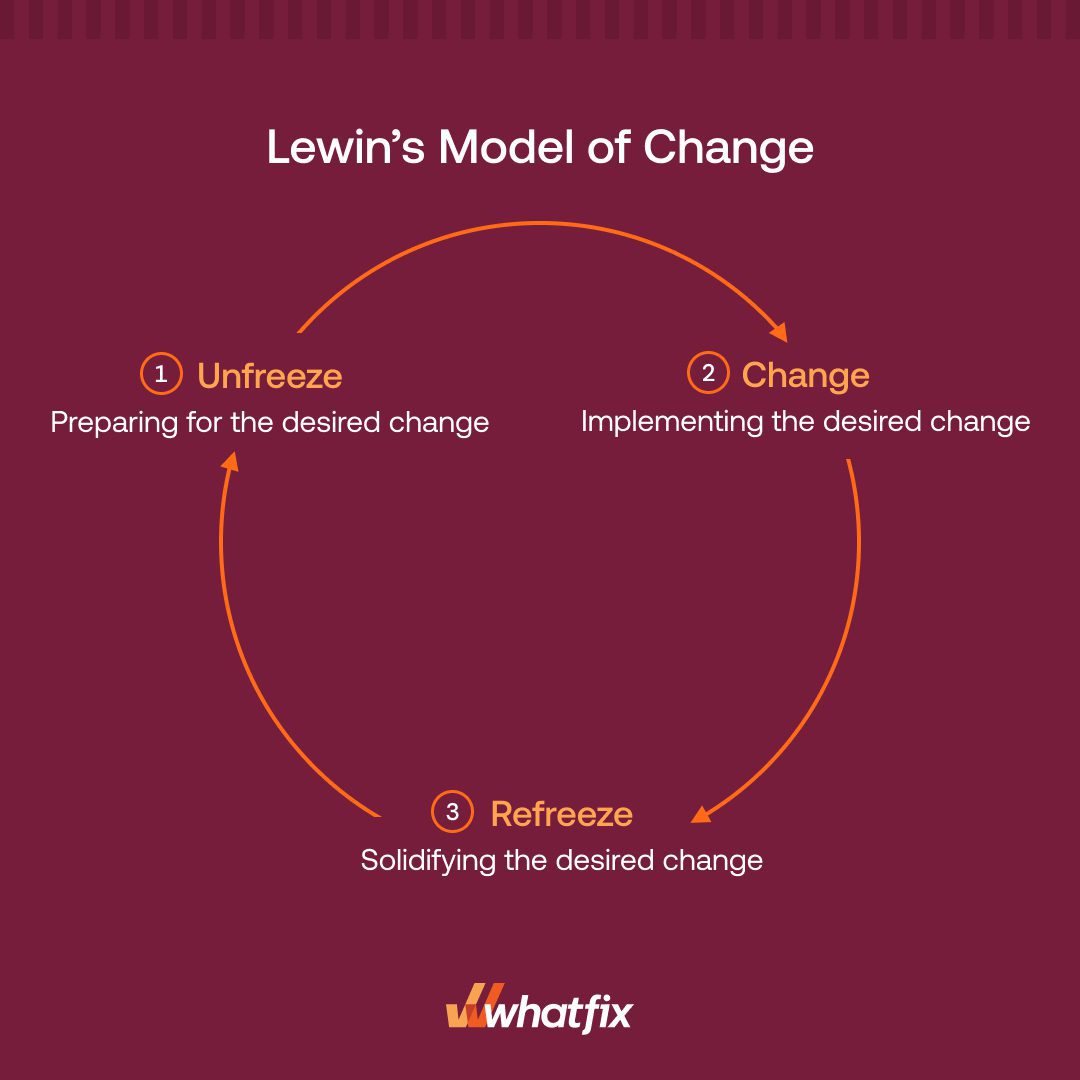Lewin’s 3-Stage Model of Change Theory
Lewin’s 3-Stage Model of Change Theory: Overview

Change is the foundation for organizational development. Yet, most employees prefer the status quo over transformational change. Change management models are designed to help you navigate through transitional phases and guide your team members towards adapting to new change – allowing businesses to maximize ROI.
One popular change model was proposed by change leader Kurt Lewin, which balances the driving and restraining forces to manage organizational changes such as digital transformation, software implementation, and business process improvements.
What Is Lewin’s Change Model Theory?
Kurt Lewin’s Force Field Theory states that restraining forces influence the behavior of both the group and individuals, ultimately deciding the fate of change. The driving forces motivate & steer employees towards the new state. The restraining forces highlight potential resistance to change, acting as the prime barriers to change initiatives.
Lewin suggests that it is crucial to balance these forces through effective change communication and employee involvement, by providing employee training to bridge the skill gap. Change agents must implement stress management techniques, ensure compliance is met, and use convincing change reasoning.
The 3 Stages of Change in Lewin’s Model
To substantiate his Force Field Theory, Lewin suggested a straightforward 3-step change model which aids employees’ ability to adapt to change.
Here are the three stages in Lewin’s change model:

Stage 1 - Unfreeze
The first stage in Lewin’s model deals with perception management and aims to prepare the affected stakeholders for the upcoming organizational change. Change leaders must look at ways to improve the company’s preparedness for change and create a sense of urgency similar to Kotter’s change model.
During this stage, effective change communication plays a vital role in getting the desired team member buy-in and support of the people in the change management.
The following activities under the ‘unfreeze’ stage will help you embrace change better:
- Conduct a needs analysis by surveying your organization to understand the current loopholes in the business processes
- Obtain organizational buy-in
- Create a strategic change vision and change strategy
- Communicate in a compelling way about why change has to occur
- Address employee concerns with honesty and transparency
How Can Lewin’s Change Model Be Implemented?
There are three major ways that Lewin’s 3-stage change model can be applied for organizational change, including:
- Changing the Behaviour and Skills of a Workforce: More often than not, every change initiative requires behavior modification and continuous upskilling of employees. Building on an existing skillset allows employees to take over more responsibilities. Therefore, it’s crucial to offer continuous employee training until the change is second nature.
- Changing the Processes, Structures, Systems in an Organization: Successful change initiative requires a balanced approach to changing the business processes, structures, and systems. For example, McDonald’s incurred multi-billion dollars loss due to its inability to balance innovation against process efficiencies. It failed to recognize how extensive customization to its food preparation would impact its speed and increase operational costs.
- Changing the Culture of an Organization: McKinsey suggests that companies with strong culture achieve up to 3x shareholder returns. To reap the long-term benefits of any change initiative, you must anchor the changes in org culture. For example, Hubspot values culture and product equally. It has an extensive 128-page culture code check to ensure that its culture stays strong as ever. Additionally, Hubspot takes an employee-first approach and invests heavily in employee development and upskilling.
An Example of Lewin’s 3-Stage Model in Action - Nissan
To understand Lewin’s change theory, let’s look at the case study of Nissan and how it supported and drove its change initiative by applying the theories of Lewin’s 3-stage change model.
The Japanese automaker Nissan Motor Company was on the verge of bankruptcy due to its huge debt and constantly declining market share. However, Nissan entered into a strategic alliance with Renault under the change agent Carlos Ghosn where Nissan aimed to get rid of its financial debt. At the same time, Renault wanted to expand its market share.
Carlos Ghosn was faced with the challenge of implementing a transformational change and turning around the operations of Nissan to make it profitable. He formed multiple cross-functional teams to reduce employee pushback and recommend a robust action plan in different functions. He developed a strong change management strategy to tackle various business challenges and increased employee involvement in the change journey through effective communication and positive reinforcement.
For refreezing the behavioral change of the team members, he introduced performance-based pay, empowered employees to try non-conventional methods, and implemented an open feedback system for guiding and facilitating the employees in enhancing workplace adaptability.
Lewin’s change model is a simple and easy-to-understand framework to humanize the change management process. These three distinct stages of change (unfreeze, change, and refreeze) allow you to plan & implement the required change. A well-thought combination of change models and change management tools can go a long way in steering your employees through the change.
Discover how Whatfix can be your partner in change with intuitive change management features such as contextual in-app guidance, guided walkthroughs, and behavioral analytics.
credit:https://whatfix.com/blog/lewins-change-model/
Comments
Post a Comment